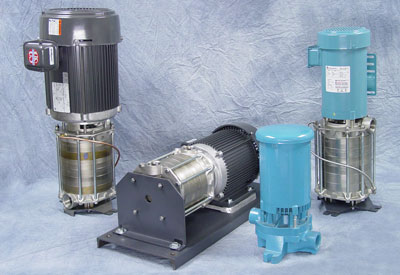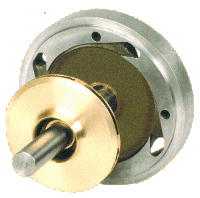

MTH masters one of the most critical design considerations of regenerative turbine pumps - the shaping of water passageways to achieve maximum capacity and pressure while minimizing horsepower requirements. By optimizing water passageway cross-sectional profiles for each impeller, MTH improves both efficiency and pressure in the M50 Series, and exceeds the standards realized by previous techniques.
One of the most notable improvements in regenerative turbine pump technology, incorporated in M50 Series pumps, involves the ability to determine the optimum impeller width and blade length. These factors have a significant effect on the required horsepower versus pressure curve for regenerative turbine pumps. By optimizing these for each pump, peak efficiency is improved and "off peak" horsepower requirements are reduced as well.
After the most favorable impeller profile has been determined for a particular water passageway cross-section, MTH calculates the number of blades needed to maximize the performance of that pump. The blade design in M50 Series pumps increases both efficiency and design pressure without incurring the manufacturing difficulties associated with producing contoured blade impellers. State-of-the-art computer controlled machines simplify manufacturing of the various MTH impellers utilized in the M50 Series. The result is a high performance pump providing efficiency characteristics exceeding those of much more expensive units.
M50 • L50 Series regenerative turbine pumps meet low net positive suction head (NPSH) requirements without efficiency loss. This is achieved by keeping the inlet fluid velocity low and then gently accelerating to passageway velocities. Special ramps are responsible for this gentle fluid entry into the impeller blades and account for the high inlet efficiency of the M50 • L50 Series pumps.
Low NPSH Requirements |
 |
L50 Series regenerative turbine pumps have exceptionally low NPSH requirements, making them ideally suited for applications where very little inlet head is available. This reduced NPSHR provided by the L50 Series is obtained by using a first stage centrifugal style impeller with inlet flow paths shaped to maintain a constant fluid velocity. This reduces entry losses to the impeller as well as maintaining efficiency. A multi-vane diffuser is used in conjunction with the centrifugal impeller for balancing radial loads and extracting the maximum pressure from the first stage. Pressure and flow produced by the NPSH inducer assures that the succeeding stages are adequately fed. |
For a copy of the M50•L50 Manual and M50•L50 Parts List, go to the Product Support Page.
Download a printable version of the M50•L50 Product Bulletin in .pdf format.
Download a printable version of theM50•L50 Catalog Pages (curves and dimensions) in .pdf format.